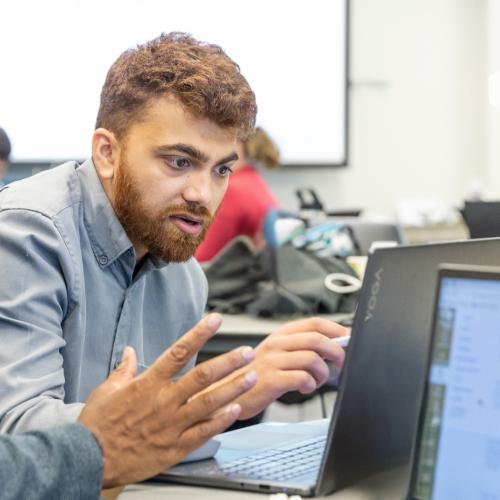Defense Tech Celebrates 50 Years
A brief history of the vital role of Radar, both in the industry and with Georgia Tech

For over five decades, Georgia Tech has been a prominent leader in defense technology training and research, led by highly respected scientists, engineers, and subject-matter experts from Georgia Tech Research Institute (GTRI). These defense technology leaders are regularly tasked to consult and work with the military, government, and a wide variety of businesses. Their experience and expertise positions them to provide valuable insight in a complex and sensitive industry.
As a preeminent research institution, Georgia Tech also translates their institutional knowledge into course and certificate offerings in a wide variety of defense related topics, from airborne and space tech to sensor and data fusion. While the program as it stands today commands a robust list of offerings, it all started with one course - Principals of Modern Radar. This year, as we mark 50 years of Defense Technology at Georgia Tech, we take a look back at the importance of that first course and what started it all.
The development of radar as a technology first came to public attention during World War II, but its wide range of applications have prompted continued investment in research ever since. While most often referenced in the context of the defense industry, it has grown to include uses in commercial, industrial, medical, weather and automotive systems as well.
Modern military uses of radar have advanced significantly from those first blips on the screen in the WWII era, now making up an extensive list, including ground surveillance, guided missile targeting and anti-missile systems, search, air traffic control and collision avoidance controls, moving target indication, targeting location and much more.
Early Beginnings
Given the clear importance and integral nature of radar systems, it is no surprise that during Georgia Tech's initial phases of their long-standing affiliation with the defense industry, Principals of Modern Radar was selected as the inaugural course offering in 1969.
The idea of translating research into courses began as an experiment initiated by Allen Ecker, PhD, director of the Applied Engineering Laboratory at the Engineering Experiment station, which, in 1984, became the Georgia Tech Research Institute (GTRI). His goal was to connect researchers with government and industry partners to identify joint research project opportunities.
A few years after the first course began, a new researcher, Bill Holm, fresh from finishing his PhD in Physics, joined the team at GTRI. At that point, Holm had already spent nine years at Georgia Tech completing three physics degrees and working as a graduate teaching assistant.
As a trained physicist, Holm wouldn’t have predicted he’d end up working in the defense tech industry. However, his path to a lifelong career first started with serendipitous research projects in radar in the Systems and Techniques Laboratory, which later morphed into the Radar and Instrumentation Laboratory and is now the Sensors and Electromagnetic Applications Laboratory. Holm worked with Jerry Eaves, then head of the bedrock Principles of Modern Radar course.
While at the time he knew very little about radar technology, Eaves had faith Holm would quickly get up to speed using the ingenuity he had developed during his physics training. Eaves’ hunch was correct, so much so, that within two years Holm was teaching in the course himself.
Upon Eaves’ retirement in 1991, Holm became the course administrator of the Principles of Modern Radar course. In 1998, Holm was appointed as the first Director of the Defense Technology program by then GTRI director Ed Reedy, PhD. His charge was to expand on the initial experiment in order to grow the program. By engaging the faculty, they hoped to develop new course opportunities based on the areas they were researching.
Expansion and Growth
Fast forward to the early 2000s, after several years of progressive leadership as a researcher and educator, in 2003 Holm was appointed to the position of interim Associate Vice Provost (AVP), now an Associate Dean position, with Georgia Tech Professional Education, and then permanent AVP in 2008. Along with his AVP duties, Holm continued as the Director of the Defense Technology program. Although he retired in 2012, Holm continues as the program director of the Defense Technology program as a retired-but-working (RBW) employee.
Now, with decades of experience as a researcher, educator, faculty member, and administrator, Holm has seen a lot of growth and change. “Back then, the Defense Technology program offered a handful of courses in addition to Principals of Modern Radar,” says Holm. “Now we’ve grown to 110 courses, as well as 13 professional certificates. It's been quite a phenomenon.”
Although the beginnings of Georgia Tech’s investment in radar research started over 50 years ago during a much different technological era, the advancements it has made along with the expanse of potential uses has allowed it to remain a significant component of both defense and civilian technology.
Even though it has evolved, Georgia Tech's long-standing partnership with the defense industry as an educational provider has remained unique. “One reason the program has accomplished so much is that there are very few, if any, other educational programs that are defense, technology, or radar related,” says Holm. "While an understanding of this technology has sweeping applications, it is not something one can learn during their formal academic training."
Recognized Leader
There are several other Research 1 institutions participating in active radar and defense research, but the choice to also convert that research into an educational product for the industry sets GTRI apart.
However, it’s not just providing the courses, it is also securing the right kind of faculty. “I think the success comes mainly from the instructors. You can be a really good researcher but not good in the classroom," says Holm. "With our instructors, their active role in the research makes them subject-matter experts, but they also enjoy teaching, which is a plus.”
That passion for research and teaching coupled with the opportunity for the change and progression that radar provides researchers has been key to its 50-year existence at Georgia Tech.
“While the technology has certainly advanced there is still so much more that can be done. It’s really hard to predict where it will be in fifty more years, ” says Holm. “It’s tempting to say, 'it’s already a mature technology so I don’t know where we go from here,' but you could have said that fifty years ago and look how much has changed.”
That notion in itself is what has not only secured decades of research, but promises much more for the future.
Interested in finding out more about the Defense Technology courses offered at Georgia Tech? You can search our upcoming offerings.

